Text
Social gaming

Playing games is something that’s always been inherently social; whether it be an intense game of monopoly that almost ends in a family feud, organizing foursquare tournaments in the primary school playground, or playing eye-spy in the car on a road trip. it makes sense that we can now share our on-screen gaming experiences with others too.
The rise of social media platforms such as Facebook has led to “new” genres of games being integrated into social networks, (Nettleton & Chong 2013) and increased users’ level of engagement with both the social platforms and the games themselves, as well as their ability to interact with other users via these channels.

Nettleton & Chong suggest that there are several features that characterize an online game:
Based on social platforms and communities
Available for access readily through mobile phone applications and mobile social networks
Prominent social aspects and heavy emphasis on social interaction
Casual gaming
Easy-to-learn, easy-to-play
Free to play
Virtual currency
The term social gaming has come to encompass a colossal amount of online games that all provide different and unique user experiences and encourage players to connect with each other in different ways.
“Ask the commuters around you, ask the flight attendant or your travelling companions if they’re gamers, you will likely get a lot of “no”’s. Ask them all if they’ve every rocked out to ‘Beatles Rock band’ on their Wii or Boggle on their iPad and you will likely get a lot of “yesses” (Harz, 2010)
This quote emphasizes the comprehensive nature of social gaming; although a large amount of people wouldn’t consider themselves “gamers”, many will also be able to remember a time where they have sought enjoyment from these forms of interactive media. Many users are also attracted to the inclusive nature of these games as you do not have to be a specific type of person to participate or take an interest, and they are readily available whenever and wherever users wish to play.

For some, online gaming can be used to provide an escape from the pressures and stresses of the real world, and users are able to step into another reality or play out someone elses life for a little while. Some studies have proposed that the typical online social gamer is looking for a “pleasant boredom through repetitive activity with low suspense, low cognitive load and emotional intensity.” (Deterding, 2010) They are designed to allow participants to feel a sense of accomplishment by interacting with them, making sure they come back for more.
Digital communities in the online gaming world also have the ability to bring people together, and allow strangers who may share similar views or interests to interact with each other online. Gamers can make and maintain long-distance friendships with people all over the world purely by connecting in the online social gaming sphere. In addition to the ability to meet new people, social gaming can act as a strengthening tool for currently existing friendships and provide a platform to interact with each other that differs from their day to day life. As more and more new technology is developed in the gaming world, even more possibilities are opened up and the future potential for the social gaming industry becomes greater every day
REFERENCES
Deterding, S (2010) Social Game Studies: A Workshop Report, Hans Bredow Institute for Media Research, Hamburg
Harz, E. (2010). Everyone and their mother’s a gamer, from Mediaweek, 20(27), 18.
Milligan, M (2018) Gaming goes mainstream for both playing and watching, Limelight networks, retrieved from https://www.limelight.com/blog/state-of-online-gaming-2018/
Nettleton, J & Chong, K (2013) Online Social Games – The Australian Position’, from Addisions, retreieved from http://www.addisonslawyers.com.au/knowledge/assetdoc/1496179efe668027/Online%20Social%20Games%20-%20The%20Australian%20Position.pdf
IMAGES
https://mashable.com/2012/12/17/simpsons-villageville-video/#S8As_w4Xi5qc
https://www.brainsins.com/es/blog/social-gaming/106106
https://twitter.com/weratelizards/status/702170790322642946
7 notes
·
View notes
Text
Yes.
TIL Paris Hilton is a huge Nintendo fan and wants to see Nintendogs for mobile
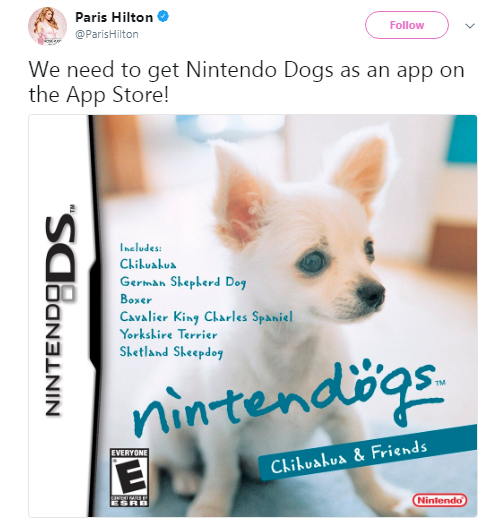

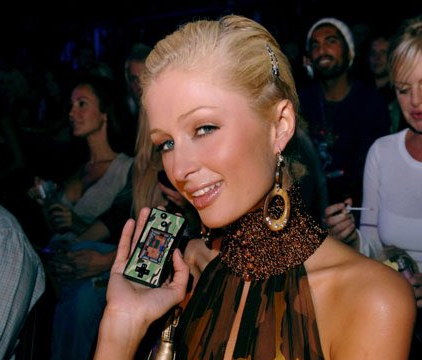
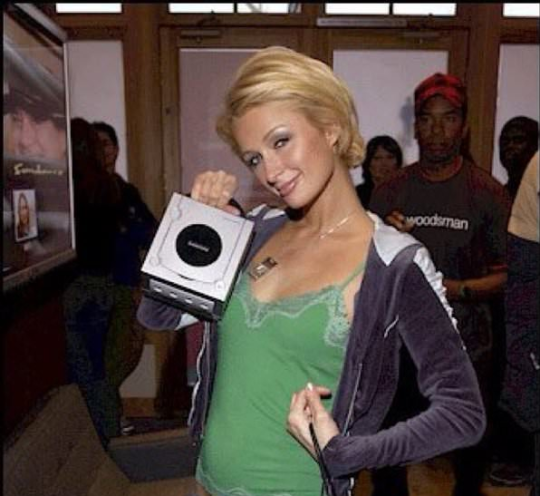
33K notes
·
View notes
Video
I loooove this video and its message - you never really know the impact your words/actions can have on someone until its too late.
It’s sad that showing compassion or empathy towards others isn't something we already do automatically, and it shouldn't be technology’s duty to make sure we aren't mean to each other
youtube
(via https://www.youtube.com/watch?v=vWBvXRVMPDU)
ANTI-BULLYING CAMPAIGN
11 notes
·
View notes
Photo

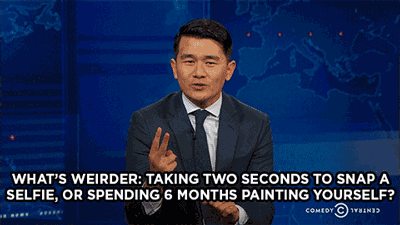
May 5, 2016 | Ronny Chieng on The Daily Show talking about selfie culture
9K notes
·
View notes
Text
Great post! It adds a lot of perspective to read about the experience you’ve personally had with trolling and the impact that this has had on your life offline as well as just your online interactions. I’m glad to hear you sorted things out but it sounds like a stressful situation that probably wasn't handled in the best way possible. Something like this is a tricky situation to deal with as theres no real way to tell where these trolls are coming from, what might have provoked them to act in this way, or what they're planning to do next.
My questions for you are:
What rules/regulations/restrictions do you think need to be put in place or could be put in place to combat this or prevent it from happening in future?
Are you able to apply this same concept to diffuse other instances of online conflict? Can you also apply this to other sites as well as just eBay?
Trolling and social media conflict.
A Troll is defined as a person whose intention is to disrupt, cause and or inflame conflict online for the sake of their own amusement (Phillips, 2015). Internet trolling can take on various forms such as harassment, verbal attacks, cyberstalking and provocative behaviours designed to prompt an affected comeback (Hosie, 2017). I’ve had my own experience with an internet troll recently which actually prompted me to seek assistance from Police. Going on what I’ve learned from that experience I believe Australia does need a cyber-safety or social media ombudsman.
As I’ve mentioned in my previous blogs I mainly only use Facebook as far as social media platforms go. I run an online store on eBay which I advertise through a Facebook page and one night earlier this year I began receiving comments on a product in my store. It’s an offensive T-shirt, designed by myself. It reads ‘Gods not Real’ on the front and ‘Grow up!’ on the back. I was inspired to print them during the marriage equality campaign in 2017 after an encounter I’d had with a supporter of the Australian Christian Lobby. You might say I was engaging in a bit of trolling behaviour myself. Anyway, the comments section on the advert I was running included a frame capture from Google maps of my house. They had taken my address from my Facebook Business page and were using it to threaten me. I contacted Police who referred me to ACORN, Australian Cybercrime Online Reporting Network. As the trolling continued I sent frame captures of the behaviour to ACORN but they just referred me back to the Police. The Police then advised that I take out an intervention order but as I did not have an address for the trolls the order couldn’t be served. By this stage the trolling behaviour had been going on for a week. I had blocked the ringleaders, but they organised a flagging operation against my page. People I didn’t know were flooding my page with negative reviews and comments. I wrote to The Hon. Philip Dalidakis, minister for small business and his staff referred me to the website of the eSafety commissioner. I looked over the website but all the measures they were taking seemed to be aimed at protecting children.
The process of obtaining a restraining order took over a month. I had to resort to some stalking tactics of my own to obtain addresses for the ringleaders but once I did so and the restraining order was issued the trolling stopped. The whole process was prohibitive and stressful. Based on my own experience I think the approach is to ‘governing’ online behaviour and social media practice is ineffective.
References:
Anon 2018, “eSafety Homepage”, Office of the eSafety Commissioner, viewed 1 May, 2018, <https://www.esafety.gov.au/>.
Hosie, R 2017, ‘Online Trolls: Why do people become Cyberbullies?’, The Independant, 7 March, viewed 1 May 2018, <https://www.independent.co.uk/life-style/online-trolls-why-people-become-cyber-bullies-social-media-twitter-facebook-study-cornell-stanford-a7616126.html>
Phillips, W 2015, This is why we can’t have nice thing, The MIT Press, Cambridge, Massachusetts, pp. 18-26.
4 notes
·
View notes
Text
Crowdsourcing in times of crisis
As I scroll through Facebook procrastinating instead of writing this blog, one of the first things I’m met with is this:

I’m not sure if its trying to tell me one of a few things
a) That I should do some work
b) That Zuckerberg really is spying on me
c) That I should donate blood
d) That crowdsourcing can be a valuable tool to provide resources (like blood) for those in need and can have a real impact on peoples lives
e) All of the above???
Thinking about crowdsourcing in times of crisis immediately draws my mind towards things such as natural disasters or acts of terrorism, where social media is used to show support or raise money for those impacted by these events. However, I’d never really thought about the use of social media as a tool for gathering (sourcing) resources from people (crowds) outside of situations like these, as obvious as it may seem in hindsight.

The Australian Red Cross is an organization who’s work revolves heavily around helping others in crisis situations and they place emphasis on “building a better society based on people helping people.” (Australian Red Cross Website) They are able to combine the resources of many to benefit the wider community and make a positive impact in potentially dangerous situations. Their slogan “the power of humanity” almost encompasses the concept of crowdsourcing as a whole
Scrolling (read: procrastinating) a few posts down my timeline, I then came across this:

This was posted by a girl I went on a Contiki tour with almost two years ago, and I haven’t had any contact with her since then, however I see her make statuses similar to this semi regularly. She is a singer/performing artist and quite often helps organize gigs and events, and uses social media as a tool to try scope out other performers and musicians that can get involved.
Admittedly planning a social event isn’t quite a time of crisis, but it made me realize how crowdsourcing can be useful in a whole range of different situations and that the collaborative nature of this can benefit all parties, not just the the victims of a crisis or the organization in charge.

“Crowdsourcing is a way of solving problems and producing things by connecting with people online that you otherwise wouldnt know”
Social media’s prolific ability for us to connect with one another is not only relevant in our every day lives but also be an amazing way to share information in times of crisis, and can be used to bring people, information and resources together when it matters most.
Obviously when disaster strikes, we’re not usually expecting it, and if you find yourself in an unexpected or dangerous situation, it can be difficult to know where to turn for help. Real-time information has proven be invaluable, and as Ford observed, in times of crisis such as natural disasters “news moved faster on social media than it did through traditional news outlets,” (Ford, 2012) and if your health or safety is threatened, you often don’t have time to wait around until the 6’o’clock news to determine the severity of the situation or establish how to react.

Ford comments on the ability of crowdsourcing platforms to “change the velocity and nature of political events,” (2012) as they allow people to both contribute to and benefit from sharing information by joining forces with others in order to have the most powerful and beneficial impact.
People can access vital information by connecting online with things like hashtags, social media sites and forums- tools that are all used as an attempt to crowdsource information and have become useful in the aid of reaching safety in dangerous situations.

REFERENCES
Australian Red Cross Website https://www.redcross.org.au/about-us
Australian Red Cross Facebook https://www.facebook.com/AustralianRedCross
Ford, H (2012) Crowd Wisdom, from ‘Index on Censorship’, vol. 41, no. 4, retrieved from http://journals.sagepub.com.ezproxy.lib.swin.edu.au/doi/pdf/10.1177/0306422012465800
Howe, J (2006) The Rise of Crowdsourcing, from ‘Wired’, retrieved from <https://www.wired.com/2006/06/crowds/>.
IMAGES
http://rtrfm.com.au/story/humanitarian-settlement-program/
http://barnraisersllc.com/2017/10/surprising-facts-collaboration-workplace/
https://www.habitatforhumanity.org.uk/what-we-do/disaster-response/
https://www.nytimes.com/2016/08/06/arts/this-is-fine-meme-dog-fire.html
1 note
·
View note
Photo

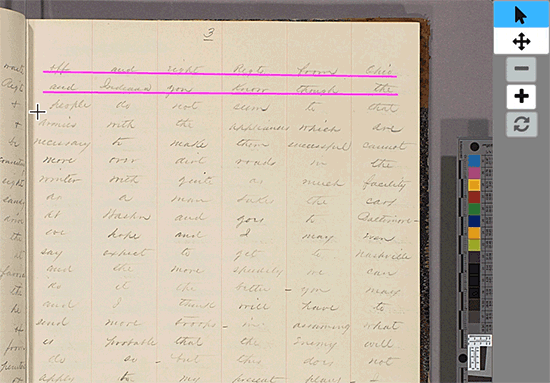
We need your help!
We have nearly 16,000 U.S. Civil War telegrams in our archives, and now you can help transcribe them! New crowdsourcing project “Decoding the Civil War” is a joint effort of The Huntington, the Abraham Lincoln Presidential Library and Museum, North Carolina State University’s Digital History and Pedagogy Project, and citizen science site Zooniverse.
Read more on VERSO.
images:
“Decoding the Civil War” landing page on Zooniverse.
Transcription gif from the “Decoding the Civil War” tutorial.
3K notes
·
View notes
Text
Myspace is the Blockbuster of Social Media.

19K notes
·
View notes
Text
Emoji’s are an interesting thing to consider in the context of cyberbullying or online harassment as they're not something I would usually associate with causing harm. Although they're generally used in an informal, lighthearted way, I can definitely see how they can be used to spread negativity or construct a particular message
If pictures speak a thousand words, how many words make up an emoji?
So much meaning can be lost or added over the internet depending on things like tone, delivery, context and intent, which makes trolling and cyberbullying such a complex issue to tackle as its not always black and white
I decided to have a quick google about the way emojis have been used in relation to cyberbullying and found this- although its not what I was looking for it is an interesting initiative... but I’m not entirely convinced it would help solve the issue. What do you guys think? Is this unnecessary or a step in the right direction?
Trolling & Social Media Conflict
Bullying has been around for hundreds of years, with the introduction of technology brings social media and the newest platform where trolling occurs. A social media troll, by definition, is someone who creates conflict on sites like Twitter, Facebook and Reddit by posting messages that are particularly controversial or inflammatory with the sole intent of provoking an emotional response from other users (Huffington Post, 2017). People posting personal information about themselves online and others manipulate this information to portray someone leaving the person vulnerable. Vulnerability is defined as ‘uncertainty, risk and emotional exposure’ (Taylor, 2016). Bullying Zero Australia 2017 reports that teenage girls are most vulnerable to trolling online.
Trolling online can result in lifestyle problems for the victims such as
*Disconnection to peers
*Low academic achievements
*Low self esteem
*Increase of depression and substance use
*Higher indication of vulnerability leading to further bullying
*In extreme cases, suicidal behaviour and thoughts. (Victorian State Government,2017)
Whilst I was going through my teen years social media was only being introduced. In fact Myspace was most common to have whilst I used to sneak on the old dial up internet to have a chat with my friends on MSN Messenger. Looking back I don’t recall social media trolling, there was a lot less platforms to join to meaning less opinions expressed and less objections to other opinions which reduces trolling, similar to when a city gets larger so does the crime.

Trolling is unavoidable and not everyone gets along civil there is always someone who speaks their mind.It can be anonymous, direct, indirect and sometimes accidental.

Whilst there is law in place under the Criminal Code Act 1995 (Cth) it is an offence to use the Internet, social media or a telephone to menace, harass or cause offence. The maximum penalty for this offence is three years imprisonment or a fine of more than $30,000 (Australian Cybercrime Online Reporting Network, 2018). Whilst there are anonymous ways to post could the law be avoided due to this? Or is there the ability to trace this anonymous troll? I think all social media platforms should have a profile created and confirmed. But will that stop the nasty trolls from creating ‘fake profiles’?
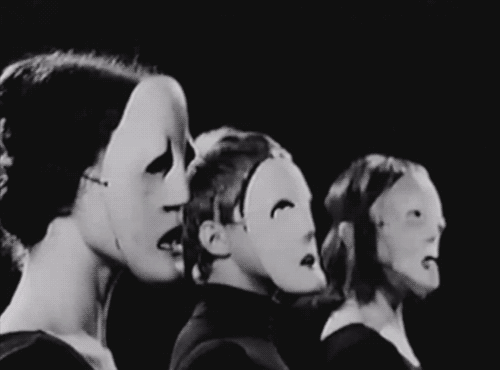
Fuller (2014) makes a suggestion - should all social media platforms make all user under 16 have parental approval to have a social media account. Which leads me to the question, do you think this is appropriate? I’m not a parent however I fear for my future children and their social media experiences. I feel this could help limit teens creating accounts with parental knowledge but however what would stop teens from forging their parents approval?
Anon 2018, “Troll Stock Illustrations. 2,405 Troll clip art images and royalty free illustrations available to search from thousands of EPS vector clipart and stock art producers.”, Canstockphoto.com.au, viewed 30 April, 2018, <https://www.canstockphoto.com.au/illustration/troll.html>.
Australian Cybercrime Reporting Network, 2018, Cyberbulling, Australian Cybercrime Reporting Network, viewed 20th April 2018
https://www.acorn.gov.au/learn-about-cybercrime/cyber-bullying
Fuller, G 2014, “‘Cyber-safety’: what are we actually talking about?”, The Conversation, viewed 28 April, 2018, <https://theconversation.com/cyber-safety-what-are-we-actually-talking-about-23505>.
The Huffington Post. (2017). Answering a Social Troll - What You Need to Know. [online] viewed 20 April 2018, http://www.huffingtonpost.com/andre-bourque/answering-a-social-troll_b_6625654.html
Taylor, J 2016, Vulnerability Is, Habits For Wellbeing, viewed April 22 2018
State Government of Victoria, 2017, The Impact of Bullying, Department of Education, viewed 24 April, 2018, .
http://www.education.vic.gov.au/about/programs/bullystoppers/Pages/impact.aspx
4 notes
·
View notes
Text
I’m the same- I’ve never taken much of an interest in crowdsourcing but in saying that I get most of my news from social media platforms, and I’ve seen it being used as a tool to have a really positive impact. I used to think that crowdsourcing was basically just people getting other people to do the hard work for them, like when a company asks the public to name their new product or suggest a new idea they can profit from without offering much in return, and admittedly this is a form of crowdsourcing I still don't like. However a lot of the time I actually really enjoy reading individual peoples responses using the hashtags etc that are created to crowdsource information as it can give an unbiased, unfiltered version of events and allows you to see things from a different perspective which is interesting!
Week 8: Crowdsourcing - it used to annoy me because I’m a terrible person
When I was researching crowdsourcing for our group assignment, what surprised me was how ubiquitous it was and how, for the most part, it greatly annoyed me. I had previously thought of crowdsourcing almost exclusively as crowdfunding (which in reality is just a subset of crwodsourcing), but I realised it was present in many of my least favourite social media interactions: friends getting upset at me for not taking part in the ice bucket challenge; people posting no make up selfies; being spammed by people to vote for their baby/dog in baby/dog modelling contests; constant social media posts to raise money for this or that triathlon. I mean, well done everyone, you’re very brave/strong/motivated/your child is beautiful, but I don’t care and I’m really just here for the cat gifs so please stop clogging up my feed.
Real talk though: I challenge anyone to tell me - without looking it up - what the #nomakeupselfie was in aid of. Or what the ice bucket challenge raised awareness for. So it’s fair to say that I did not think much of crowdsourcing, and the above examples often seemed more about an individual’s vanity than an actual concern for a cause. None of my friends had ever shown a great concern for any of these causes before they offered a chance to be beautiful / hilarious on social media**.

Source: https://twitter.com/jtmlsn/status/446100295643189251
However, finding out that Shutterstock, the photo sharing website (which I use every day at work) and Wikipedia (oh, I would cite thee in every assignment if I was allowed to) are two early examples of crowdsourcing (Howe, 2006), suddenly I had a whole lot more time for it. Then when I started reading about the innovative ways in which crowdsourcing was used in response to natural disasters and crises, I started to see how valuable it could be. A simple, and very efficient, way of sharing information or directing the actions of those who wanted to help, for example the hashtag #bakedrelief was used after the Christchurch earthquakes to direct donations to where they were needed most.
Given that we now live in an always-on world, what became apparent during crises such as the Christchurch earthquake and New Zealand floods, was that news moved faster on social media than it did through traditional news outlets (Ford, 2012). Furthermore, the virtual communities that sprang up during these events helped bring a sense of camaraderie and support to those who were most directly affected. These instances of crowdsourcing developed quite organically, and led organisations such as QPS Media to look into setting up more systematic online crowdsourcing systems to harness the velocity of social media during crises, such as information verification methods (Bruns et al. 2012). Information verification is a crucial part of crowdsourcing during crises, with incorrect or intentionally misleading information potentially directing resources away from where they are needed most.

Source: http://www.performancemagazine.org/on-data-quality-and-crowdsourcing-calvin-and-hobbes/
Crowdsourcing has now become an in-built feature on many social media platforms (think Twitter hashtags and Facebook’s Safety Check feature), and most of us can’t remember a time when we didn’t turn directly to social media for information around these events. With the right tools in place, crowdsourcing has become a really powerful and positive affordance of digital communities.
**I realise I’m painting a picture of my friends as narcissistic jerks and they’re really not. I’m just trying to illustrate a point. #drama
References
Bruns, A, Burgess, J, Crawford, K & Shaw, F 2012, #qldfloods and @QPSMedia: Crisis Communication on Twitter in the 2011 South East Queensland Floods, ARC Centre of Excellence for Creative Industries and Innovation, Brisbane.
Ford, H 2012, ‘Crowd Wisdom’, Index on Censorship, vol. 41, no. 4, pp. 33-39.
Howe, J 2006, ‘The Rise of Crowdsourcing’, Wired, 1 June, last viewed 18 April 2018, <https://www.wired.com/2006/06/crowds/>.
2 notes
·
View notes
Text
Snapchat is a weird platform to think about in regards to personal photography. I agree with you that often it seems strange that we spend so much time caring about something that people only see for a matter of seconds. People seem more concerned about whether or not they’ve posted something, regardless of what it actually is and just communicate for the sake of communication.
It makes me wonder why people take so much pride in things like snapchat streaks- do you really need a number to validate your friendship with someone you communicate every day?
Week 9: Visual communities and social imaging
Images have become a fundamental part of the fabric of social networks. Not just the photos that represent us, but the photos we send to each other, and tag each other in - I have some friends that I communicate with solely through tagging in funny photos or memes. While images have always been important resources for sharing our life stories, this has increased dramatically since the advent of social media and networking (Burgess & Vivienne, 2013). Where in days past, we used to go to Uncle Gary’s house to see his holiday snaps, he now uploads them onto Facebook with the same intention of sharing a part of his life experience. Images are no longer simply the subject matter of our communication, they are a new form of communication, particularly with the advent of apps like Snapchat (Herrman, 2014). The fact that images can be created and shared in real time creates an overlap of our physical and digital communities, and the idea of these two worlds being separate (one ‘real’ and one ‘virtual’) is highlighted by Jurgenson (in Herrman, 2014) as being outdated.
Humans are motivated to engage with online communities by a need to belong and a need for self presentation (Nadkarni and Hoffmann, 2011), and images and photography provide a unique and efficient way to do this. The problem that Spiegel (in Herrman, 2014) identifies with this is the idea that we are “the sum of our published experience” that is, we start to define ourselves, and be defined, by the parts of ourselves that we share online. Where digital communities originated as a place to interact, and share our physical lives, now people curate experiences in their physical lives for the sole purposes of sharing them online. In this way, digital communities offer a place to create a new persona, whether that is an improved version of yourself, or a completely new identity. This, as Jurgenson identifies, creates a tension between experience for its own sake and experience we pursue just to put it on Facebook (Herrman, 2014).
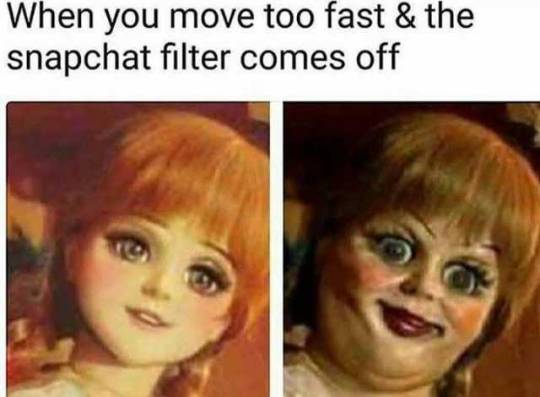
Source: dopl3r.com
YouTube takes this further with the moving image. Videos of affinity afford the same ability to belong and self present. There is something thrilling about seeing a video of yourself - it is a way to see how others in the world see you, and it validates your own experience of yourself in the world. To then share that online and have other people confirm your existence and validity, is very powerful. As bandwidths get faster, and social networks offer more video-centric features, we will only move further in this direction.
It is interesting, then, that Snapchat is enjoying such popularity. When a big part of the appeal of social imaging is creating a representation of yourself online, and creating an online legacy, this app that features ephemeral photos and videos, that disappear in an instant. Speigel’s suggestion (in Herrman, 2014) that this is because images are now becoming the conversation, rather than facilitating the conversation.
References
Burgess, J E & Vivienne, S 2013, ‘The remediation of the personal photograph and the politics of self-representation in digital storytelling’, Journal of Material Culture, vol. 18, no. 3, pp. 279-298.
Herrman, J 2014, ‘Meet The Man Who Got Inside Snapchat’s Head’, Buzzfeed, 28 January, last viewed 2 June 2018, <https://www.buzzfeed.com/jwherrman/meet-the-unlikely-academic-behind-snapchats-new-pitch?utm_term=.fgM18g2oN#.nqrqQenMr>.
Nadkarni, A & Hofmann, S 2011, ‘Why Do People Use Facebook?’, Personality and Individual Differences, vol. 52 (2012), pp/ 243–249.
3 notes
·
View notes
Video
youtube
Although this video is meant to be satirical and overdramatised, this exaggerated representation of an “insta-famous” (or maybe just self obsessed) figure genuinely reminds me of a few people I know and follow on social media.
It’s both scary and sad how at times we sacrifice parts of our identity in order to represent the best version of ourselves to the world and not necessarily live our actual lives - even though constructing the perfect life can make us feel like we’re living the opposite of a perfect life
0 notes
Quote
Needing to have reality confirmed and experience enhanced by photographs is an aesthetic consumerism to which everyone is now addicted.
On Photography, Susan Sontag (and she wrote this in 1977!)
2K notes
·
View notes
Text
Personal photography and our online identities
We live in a culture of oversharing. On average, consumers spend more than 2 hours per day using social media, (Global Web Index, 2017) with teens checking their phones 150 times per day (Brandon, 2017)
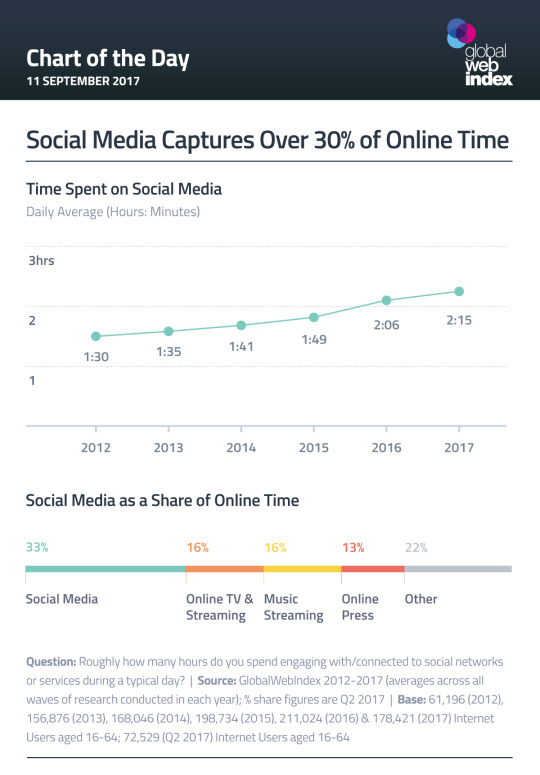
Nadkarni and Hoffman suggest that there are two basic social needs that motivate people to use Facebook:
the need to belong
the need for self preservation
Vivienne & Burgess (2013) argue that the concept of personal photography was introduced in 1888 with the development of the Eastman Kodak Camera, transforming photography from a professional process into a personal one and allowing people to capture special moments that they could look back on. Since this introduction, personal photography has now become an integral part of our online identities and changed the way we communicate.
Now instead of documenting our lives through a physical photo album, we do so through our phones using social media, and we’re faced with a constant demand to keep the world up to date.
Sarvas and Frolich note that although the value of photographs for memory, communication, and identity has not changed, the relative importance of these values has shifted, in a move away from memory and toward communication and identity (2011) creating a
never ending feed of selfies, breakfasts, sunsets and pets. Instagram users share 95 million photos and videos per day, (Osman, 2018) a statistic which in itself demonstrates a shift in the ways in which we present ourselves and our lives to our digital communities.
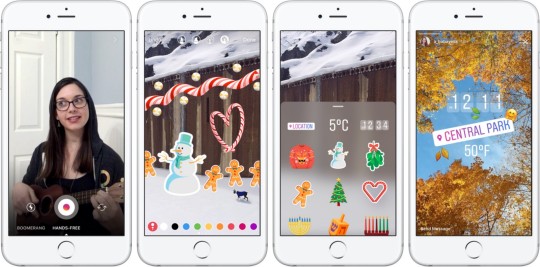
Personal photography is now a much more temporary, throwaway experience than it was in the past, despite the fact that we now have the capability and technology to take, edit, store and share images like never before. Many dominant social platforms such as Instagram, Snapchat, Messenger and Facebook now all have a ‘stories’ function, which encourages users to share photos of their daily activities that stay up for 24 hours after they’ve been posted. The temporary nature of this suggests that the actual photo or image is less important than the act of sharing it- the photo becomes the conversation starter rather than the final product, and the focus of photo-sharing platforms relies more heavily on fuelling our egos and shaping our digital identity than on the photos themselves.
We tend to stay up to date with the lives of our friends via what they’ve posted online rather than actually speaking to them face to face. Speaking about millenials constant use of social media, John Brandon says “you know what they're thinking and feeling, even if you're reading it on a screen” (2017), but the relentless pressure to gain more followers or receive enough likes often outweighs our desire to share a genuine, unfiltered version of our lives.

Producing our own content means that we are in control of how our profiles and our lives are seen by cyberspace. (Siapera, 2012). Through selection and omission, we are able to decide exactly how we want to be seen by others and we’re able to essentially construct our own identity. My favourite example of this is Zilla van den Born, a Dutch girl who staged a 5 week trip to Asia without leaving her apartment, convincing even her parents that she’d been on holidays using photoshop and a few simple props.

When asked why she decided to do this, she said “My goal was to prove how easy it is to believe in a distorted reality. I wanted to make people more aware that the images we see are manipulated, and that it’s not only the models in the magazines, but also our friends on social media who contribute to this fake reality. We should be more careful about what we believe, and ask ourselves why a photo is made — how and by whom and with which intention”
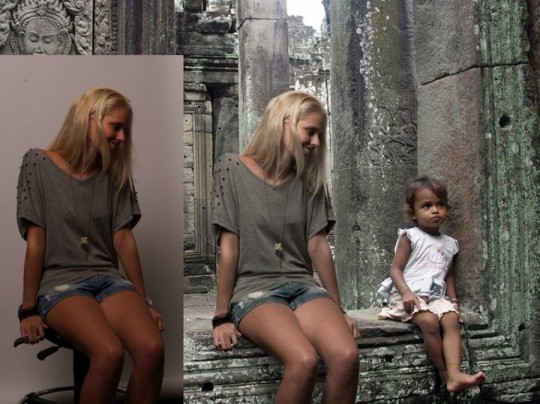

REFERENCES
Brandon, J (2017) The Surprising Reason Millennials Check Their Phones 150 Times a Day from Inc., retrieved from https://www.inc.com/john-brandon/science-says-this-is-the-reason-millennials-check-their-phones-150-times-per-day.html
Dewey, C (2014) What is reality?’: A Q&A with the artist who used social media and Photoshop to fake an epic trip even her parents fell for, from The Washington Post, retrieved from https://www.washingtonpost.com/news/the-intersect/wp/2014/09/12/what-is-reality-a-qa-with-the-artist-who-used-social-media-and-photoshop-to-fake-an-epic-trip-even-her-parents-fell-for/?noredirect=on&utm_term=.b6554a869441
Global Web Index (2017) Social Media Captures Over 30% of Online Time, retrieved from https://blog.globalwebindex.com/chart-of-the-day/social-media-captures-30-of-online-time/
Nadkarni, A, & Hofmann, S. G. (2012) Why Do People Use Facebook? From Personality and Individual Differences, retrieved from http://doi.org/10.1016/j.paid.2011.11.007
Osman, M 2018, 18 Instagram Stats Every Marketer Should Know for 2018, Sprout Social
Sarvas R., Frohlich D.M. (2011) The Future of Domestic Photography. In: From Snapshots to Social Media - The Changing Picture of Domestic Photography. Computer Supported Cooperative Work. Springer, London
Vivienne, S & Burgess, J 2013, ‘The Remediation of the Personal Photograph’, Journal of Material Culture, vol. 18, no. 3
IMAGES
https://blog.globalwebindex.com/chart-of-the-day/social-media-captures-30-of-online-time/
http://dazedimg.dazedgroup.netdna-cdn.com/936/azure/dazed-prod/1090/0/1090755.jpg
https://cdn.someecards.com/someecards/filestorage/zNqQsnorkel8bewerkt-1024x614.jpg
https://piximus.net/others/instagram-vs-reality
https://medium.com/@Ayushverma8/why-instagram-stories-rank-viewers-in-a-particular-order-7826b99b6215
#constructed reality#personal photography#instagram#social media#digital identity#representation#zilla van den born
2 notes
·
View notes
Photo




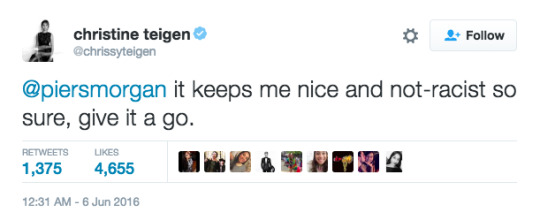

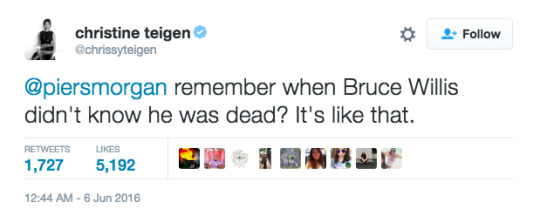

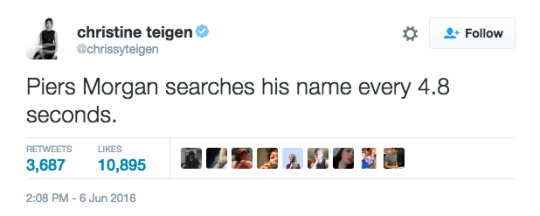

Chrissy Teigen is trolling Piers Morgan with the most delicious intensity right now
84K notes
·
View notes

